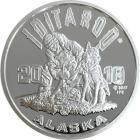The 2018 Official Iditarod Medallion


After a long delay the 2018 Iditarod is now available. Many of you were not able to order this medallion last year. So if you wish to bring your Iditarod medallion collection up to date now is the time. We are offering this piece at a special price for a limited time. This medallion will ship with your regular order for 2019.
Please click on the image for a more detailed view.
Call for availability
The Official Iditarod Medallion contains one ounce of .999 Fine Silver, individually serial numbered, with a limited mintage of 3,000 pieces. The Iditarod medallion is second only to the Official State Medallion series for after market demand.
The first running of the Iditarod Sled Dog Race began on March 3 of 1973, and ended one month later on April 3, in Nome. Today, the race is run the same distance, but in about one third of the time. The Iditarod has been run each year since its inaugural race, and in 1976 Congress designated the Iditarod route a National Historic Trail. The trail follows the old mail route from Knik to Nome, forged in 1910.
The Iditarod Trail crosses two mountain ranges, follows the Yukon River for about 150 miles, passes many bush villages, and extends across the pack ice of Norton Sound. The Iditarod is only a winter trail because the ground is covered with muskeg swamps in the summer. The trail was the spotlight of national attention in 1925 when sled dog mushers, including Leonard Seppala and his lead dog Balto, mushed 30,000 units of life-saving diphtheria serum to an epidemic in Nome. Each year the Iditarod follows an alternating southern or northern route. While the route is traditionally described as 1049 miles long, (because Alaska is the 49th state of the Union) the trail distance varies slightly each year due to safety hazards and is actually closer to 1,100 miles from start to finish.
The Iditarod Sled Dog Race is known as "The last great race on earth," and stretches over 1,000 miles across Alaska's frozen wilderness from Anchorage to Nome. The first race to Nome, organized by the late Knik resident, Joe Reddington Sr., and the late historian from Wasila, Dorothy Page, took place in March of 1973.
